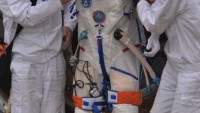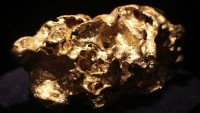Melting Ice Reveals Ancient Artifacts Frozen in Time
| Michael A. Katz | | Nov 17, 2015 06:35 PM EST |
(Photo : Getty Images) Melting glaciers are revealing ancient artifacts that have been trapped in ice and frozen in time for thousands of years.
Despite its many negative repercussions, there is one benefit of climate change that is proving to be a boon to archaeologists: melting ice is revealing ancient artifacts that have been trapped in ice and frozen in time for thousands of years.
"This is one tiny little instance where climate change is affording us the opportunity to learn something about the past," Dr. Craig Lee, an environmental archeologist at the University of Colorado at Boulder's Institute of Arctic and Alpine Research tells PNAS (the Proceedings of the National academy of Sciences). "It is the tiniest of silver linings."
Like Us on Facebook
In 2007, Lee found a 10,300-year-old hunting dart that turned out to be the oldest human artifact that has ever been discovered encased in ice.
Lee is among a small but growing number of scientists who work in the nascent field of "ice patch archaeology," which refers to the study of anthropogenic artifacts recovered as a result of melting snow and ice patches. It is also referred to as "glacial archaeology" by European researchers. Climate change is melting once-permanent ice patches at high latitudes and high elevations, which releases ancient paleobiological and archaeological materials that had until then been suspended in a cryogenic-like state.
Ice can preserve artifacts in two different kinds of sites: glaciers and ice patches. Ice has attracted ancient animals and their human hunters, and as a result have maintained an historical record of sorts on human hunting and other activities. The ice in these areas exhibit little internal deformation or movement, and it can preserve otherwise perishable materials for literally thousands of years.
It's a relatively new field that has only been around for a few decades because it had wrongly been assumed that the humans had never lived in the areas that are now permanently covered in ice and snow. But as climate change began melting glaciers and ice patches, scientists came to discover that humans used to regularly hunt and travel on the ice. It wasn't until 2008 that the first international symposium for ice archaeologists was held - appropriately enough - in the shadow of the Alps in Bern, Switzerland.
Thanks to melting ice, archaeologists in the Swiss Alps have discovered Neolithic leather clothing, Roman shoe nails, and a shoe repair kit from the 14th or 15th century. It is no coincidence that the dates of the artifacts correspond to times when the climate was warm enough to make the area passable. Lee also helped identify eight prehistoric sites in association with perennial ice patches within the Greater Yellowstone Area of Montana and Wyoming.
However, the downside to melting ice is that the artifacts no longer have the protection that had kept them in such pristine condition for thousands of years. Although the artifacts manage to stay amazingly well preserved in the ice, they begin to deteriorate immediately upon thawing. "The sad fact of the matter is, the few things we find are clearly the tip of the iceberg," Lee says. "It's inconceivable to think about what's been lost."
TagsMelting Ice Reveals Ancient Artifacts Frozen in Time, melting ice is revealing ancient artifacts, frozen in time for thousands of years, Craig M. Lee, Boulder's Institute of Arctic and Alpine Research, ice patch archaeology, glacial archaeology, one benefit of climate change
©2015 Chinatopix All rights reserved. Do not reproduce without permission
EDITOR'S PICKS
-

Did the Trump administration just announce plans for a trade war with ‘hostile’ China and Russia?
-

US Senate passes Taiwan travel bill slammed by China
-

As Yan Sihong’s family grieves, here are other Chinese students who went missing abroad. Some have never been found
-

Beijing blasts Western critics who ‘smear China’ with the term sharp power
-

China Envoy Seeks to Defuse Tensions With U.S. as a Trade War Brews
-

Singapore's Deputy PM Provides Bitcoin Vote of Confidence Amid China's Blanket Bans
-

China warns investors over risks in overseas virtual currency trading
-

Chinese government most trustworthy: survey
-

Kashima Antlers On Course For Back-To-Back Titles
MOST POPULAR
LATEST NEWS
Zhou Yongkang: China's Former Security Chief Sentenced to Life in Prison

China's former Chief of the Ministry of Public Security, Zhou Yongkang, has been given a life sentence after he was found guilty of abusing his office, bribery and deliberately ... Full Article
TRENDING STORY

China Pork Prices Expected to Stabilize As The Supplies Recover

Elephone P9000 Smartphone is now on Sale on Amazon India

There's a Big Chance Cliffhangers Won't Still Be Resolved When Grey's Anatomy Season 13 Returns

Supreme Court Ruled on Samsung vs Apple Dispute for Patent Infringement

Microsoft Surface Pro 5 Rumors and Release Date: What is the Latest?













